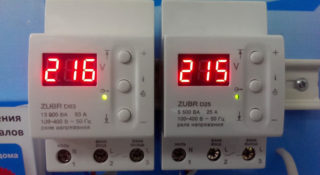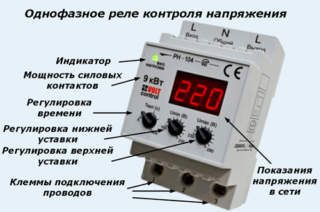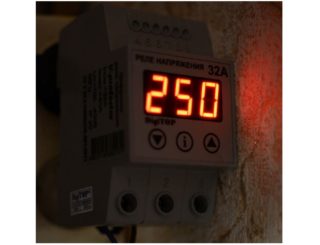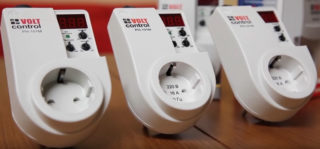A 1-phase voltage monitoring relay is used to protect household appliances from power surges in a home electrical network. This device in an emergency instantly disconnects the apartment or a separate load from the power circuits, and after restoring normal power automatically turns on again. Two versions of protective relays of this class are known, one of which is represented by devices with automatic time delay. The second models have a simpler design, setting the delay time in them is done manually.
General device and features

According to the method of installation in the serviced line, the single-phase voltage relay also has two versions. One of the varieties is made in the form of an external device that can be connected to a conventional outlet, and the other is similar to a module mounted on a DIN rail of an input and distribution panel.
The structure of any single-phase voltage monitoring relay, regardless of its type, includes the following required nodes:
- An electronic module by which the lower and upper limits of the operation of the device are set and controlled.
- Block forming a control signal.
- An actuating element in the form of a relay disconnecting the LV when the voltage exceeds the permissible limit (setting).
When the voltage in the home network rises or falls to one of the limit values, the electronic module generates a signal that supplies power to the executive relay. The latter is triggered and relieves voltage from the line, reliably protecting electrical appliances connected to sockets from high potential damage.
Advantages of installing a single-phase current carrier
The need to use a voltage relay in apartments and private houses arises for a number of reasons, the most important of which is the desire to protect household appliances connected to the network. In addition, it saves from overload machines located in the switchboard.
Typically, the protective device is installed after the meter, but in some cases, with special permission it can be connected to it. With this option, the inclusion of the pH protects the expensive energy meter, preventing unjustified costs of buying a new one.
The single-phase overvoltage relay in addition to automatic overload protection allows you to manually set the thresholds and visually observe the set values on the display screen. The values of the voltages acting at the output and input of the protective device are also displayed here.
Product Specifications
 The single-phase voltage relay mounted on a DIN rail is represented by the following performance characteristics:
The single-phase voltage relay mounted on a DIN rail is represented by the following performance characteristics:
- current voltage in the network (220 Volts);
- rated load current;
- lower and upper limits of overload trip;
- delay time before restarting the machine.
In various pH samples, the rated operating current is from 10 to 63 amperes. The last digit is taking into account the magnetic starter, which is installed additionally. Particularly noteworthy is the second parameter, which varies widely - typical frames - from 210 to 270 volts. The manual delay time for various models is selected in the range from 1 second to 10 minutes.
The characteristics of the voltage relay plugged into the outlet practically do not differ from the parameters of stationary protective devices. Their only difference is that the amount of switched power is limited to 3.6 kW - just over 10 amperes per current. There is no question of using a magnetic starter with contactors in this case - it simply has nowhere to put it.
Wiring diagram
Before connecting a single-phase voltage relay to a DIN rail, it is advisable to carefully study the internal structure of the electrical cabinet. Typically, these devices are included after the meter in the gap of the phase and neutral wires. With this choice of installation location, the LV will cut off precisely the “phase” together with the neutral supplied via cable. Only in this way it is possible to achieve its reliable operation in case of strong voltage drops.
In practice, two well-known schemes for connecting single-phase relays to the consumption line are used:
- with direct connection to the load;
- with the connection of power equipment through contactors that are part of the magnetic starter.
According to the PUE, parallel connection of several protection devices is allowed, to each of which a separate load group can be connected.
When arranging an electrical panel in an apartment or a country house, they usually resort to the first of the options considered. However, if the load chains are supposed to install powerful equipment - a three-phase pump, for example, or a heating boiler - you will have to resort to the second method of switching on. In this case, additional power circuits will be required, the switching of which is carried out indirectly through the coil of the electromagnetic starter.
A good result in this situation can be achieved through the use of a special three-phase LV, designed to operate in 380 volt power circuits.
Protection device selection
Before choosing a protective device of one type or another, it is important to determine its operating parameters that are optimally suited for specific conditions. If the user is concerned about the safety of expensive household models of a washing machine or an imported refrigerator, it is wiser to purchase a sample of the “socket-plug” type.
Such a choice is justified only on the condition that, all other equipment is already reliably protected by a stabilizer. In this case, the installation of a collective relay in the electrical panel will be unnecessary and will lead to unnecessary costs. The “socket-plug” option is more suitable for urban residents who decided to save on the launch vehicle installation, since for its installation it will be necessary to invite a local electrician. When calculating possible costs, it is necessary to understand that the purchase of several devices included in the outlet, in any case, will cost more than one stationary LV.
If the user does not have a stabilizer, as well as if the owner wants the apartment to reliably protect household equipment, it is more reasonable and cheaper to choose a device installed on a DIN rail. With the parallel connection of several voltage relays, the possibility of breakdown of expensive equipment is practically eliminated. In addition, these devices can be installed in private households, providing voltage control in a three-phase network (one for each phase).
The choice of the voltage relay connection scheme is determined by the conditions of its operation in the place of the proposed installation. When choosing it, one should take into account the values of currents in the load, which can reach limit values. In this case, it is not allowed to connect the relay directly to the serviced circuit according to the EMP. An additional element will have to be introduced into the circuit - an electromagnetic starter, the contactors of which withstand significant current loads.





